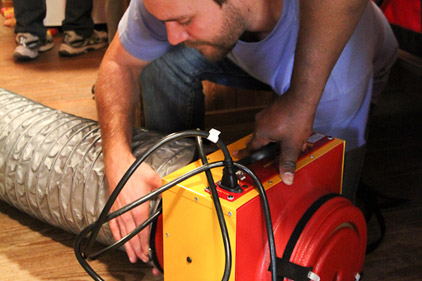
|
| Colin Genge |
Energy codes are emerging or being updated nationwide. As air leakage testing becomes a requirement, some testers wonder what value it adds over informed visual inspections. Arguments about equipment expense, training time, or that homeowner money could be better spent elsewhere seem to follow new codes.
Let’s explore the reasons why blower door and duct leakage testing actually saves auditors’ and homeowners’ time and money.
1. Results give customers faith.
If you are selling a job, it makes sense to test the ducts to give the homeowner an appreciation of the performance they are likely to get out of you versus your competitor.
If you are testing to code, don’t new homeowners warrant a test to see if their system works? Would you buy a car that had never been tested?
Save time by depressurizing. Pressurizing ducts, the way some codes require, will take twice as long because it makes sealing the registers far more difficult. You’ll get the same reading whichever direction you test — so if you want to save time, depressurize.
2. Not all data is created equal.
Are blower door readings useful? Not quite as cost effective as duct testing but reducing house leakage is often the next best service you can provide. If you perform a duct leakage test, the two can be combined so you can test duct leakage to outdoors, which negates leakage at the registers and can speed up the test. If you are doing a blower door test anyway, using it with a duct tester will give you a more meaningful duct leakage to outdoors result because the pressure is neutralized across the seal you placed on the registers.
Save time: multi-point blower door tests do little more than a single point test. In fact, if you take a baseline reading for 60 seconds and a blower door reading for 60 seconds, the result is likely to be more accurate and repeatable than the multi-point test. I strongly encourage testing standards to choose one easy and equally accurate test. This should reduce the time to attain blower door results to less than half.
3. Testing creates standards for better buildings.
Products tend to get built to the standard they are tested to and it’s safe to say that a blower door tested enclosure will typically be at least 30 percent tighter than one that isn’t. This translates into at least a 5 percent energy saving over the life of the building — to say nothing of reducing indoor pressure imbalances and moisture deposition. If a house is built to a blower door test standard, not only will it save the most on energy, it will also ensure the structure’s health and longevity.
4. Saves auditors’ time and homeowners’ money by clearly showing which upgrades are most effective.
Replacing recessed lighting, upgrading insulation, adding weather-stripping — these are all easy energy fixes. What testing offers is a way to not only see where leaks are, but to determine the best “bang for your buck.” Although you could spend time sealing in the living space, three attic bypasses could be responsible for 25 percent of the house’s total leakage and take only a few minutes to seal.
5. Drives homeowners to invest in your services.
Testing gives homeowners a way of measuring the success of their investment in your services. Blower door testing offers an objective measure of an audit, something clients will appreciate when considering an energy audit and while acting on its results.
Yes, it is possible to repair the usual suspect areas without testing, but overall we will go back to terribly performing houses as soon as we stop testing them. Products are built as well as required tests need them to be. I have seen an average new home’s duct leakage go from about 200 cfm leakage down to about 25 cfm after the installer started testing.
New cars are subject to thousands of tests during manufacture. Would you or your client buy one that wasn’t tested?
Publication date: 6/18/2012


Report Abusive Comment